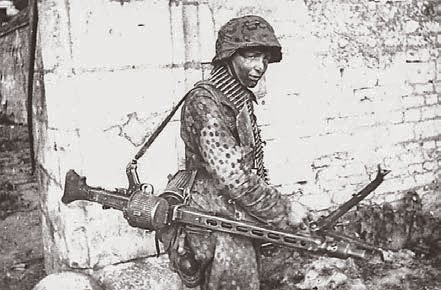The 12th SS Panzer Division Hitlerjugend went into battle for
the first time in Normandy, but gave a good account of itself as
the scourge of Canadian arms throughout the Normandy campaign.
Derisively called a baby division with a milk-bottle badge by a
disparaging Allied press, the division had been formed in June 1943
almost entirely of youths around seventeen years of age. This was a
consequence of Reichsjugendführer Arthur Axmann’s Hitler Youth
project, approved by Hitler after Stalingrad, to induct senior
Hitlerjugend with some military training into a volunteer division.
On passing the test of war, this formation would serve as a model
for the incorporation of additional volunteers into other German
divisions.
In June 1943, Oberführer Fritz Witt of the Leibstandarte assumed
command, and with other veteran officers and noncommissioned
officers from the Waffen SS and army, he instituted a vigorous
training program that stressed fitness. One suspects that easier
access to better training areas than the Allies had in Britain also
enabled them to conduct more realistic field exercises, including
live fire. The training philosophy of the Hitlerjugend appears to
have been innovative, with great importance attached to inculcating
a sense of responsibility, self-sacrifice, and comradeship. Only
eighteen-year-olds were allowed cigarettes; younger soldiers were
issued candy. The relationship between battle-hardened veterans and
inexperienced youth has been likened to that between older and
younger brothers.
For nine months, despite certain equipment shortages, the 12th
SS conducted thorough battle-oriented training. Fieldcraft—in
particular camouflage techniques learned from the Russians—received
special attention. Marksmanship training focused on shooting not on
formal gallery ranges, but exclusively in the field using
silhouette targets. Physical fitness was attained mainly through
playing sports and running obstacle courses rather than route
marching. Parade square drill took a back seat to training under as
realistic combat conditions as possible. Panzer battalions
concentrated on their basic skills, which included repair and
maintenance, driver training, radio operation, and gunnery. As
cross-training was an unaffordable luxury by 1944, new crewmen
learned only one of these jobs. Formation training from early 1944
consisted of live-fire and large-scale tank exercises that stressed
the cooperation of arms within the panzer battle group. By April
1944, the division had already suffered fifteen dead, presumably
the result of training accidents. When the 20,540 soldiers of the
12th SS Panzer Division (two panzergrenadier regiments of three
infantry battalions each and one panzer regiment with Mark IVs and
one Panther battalion) went into action, they were considered
excellently trained—as well trained as scarcely any other division
had ever been—so that their operational employment could be fully
justified. This, more than just will and fanaticism, was surely
their great forte.


No comments:
Post a Comment